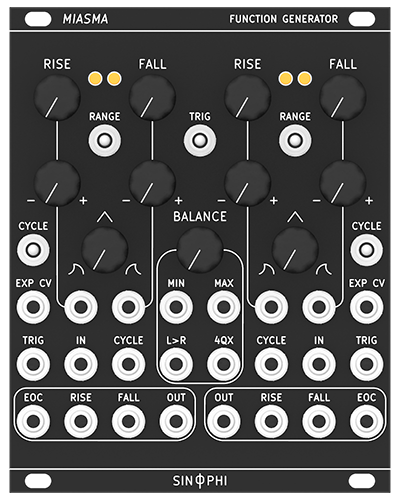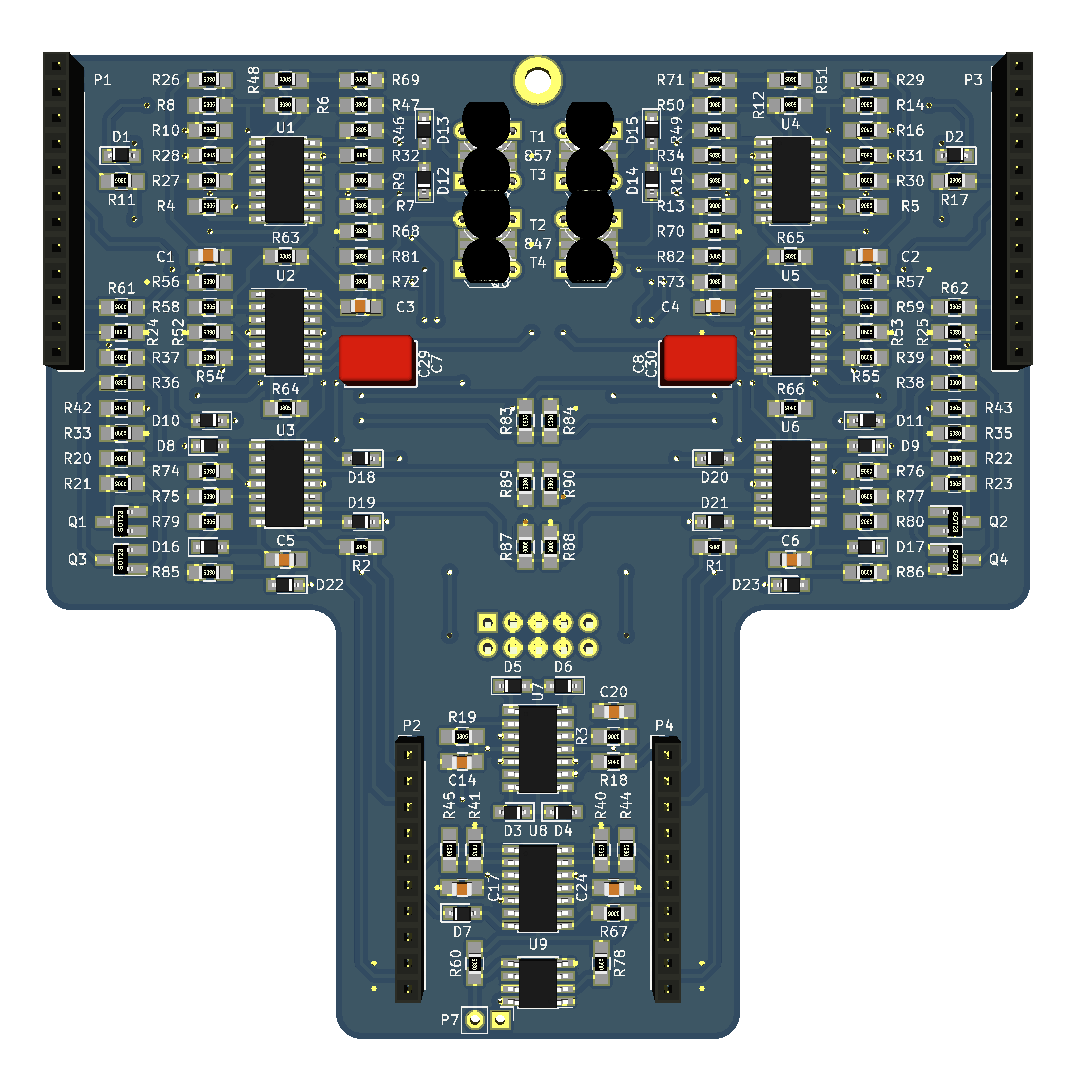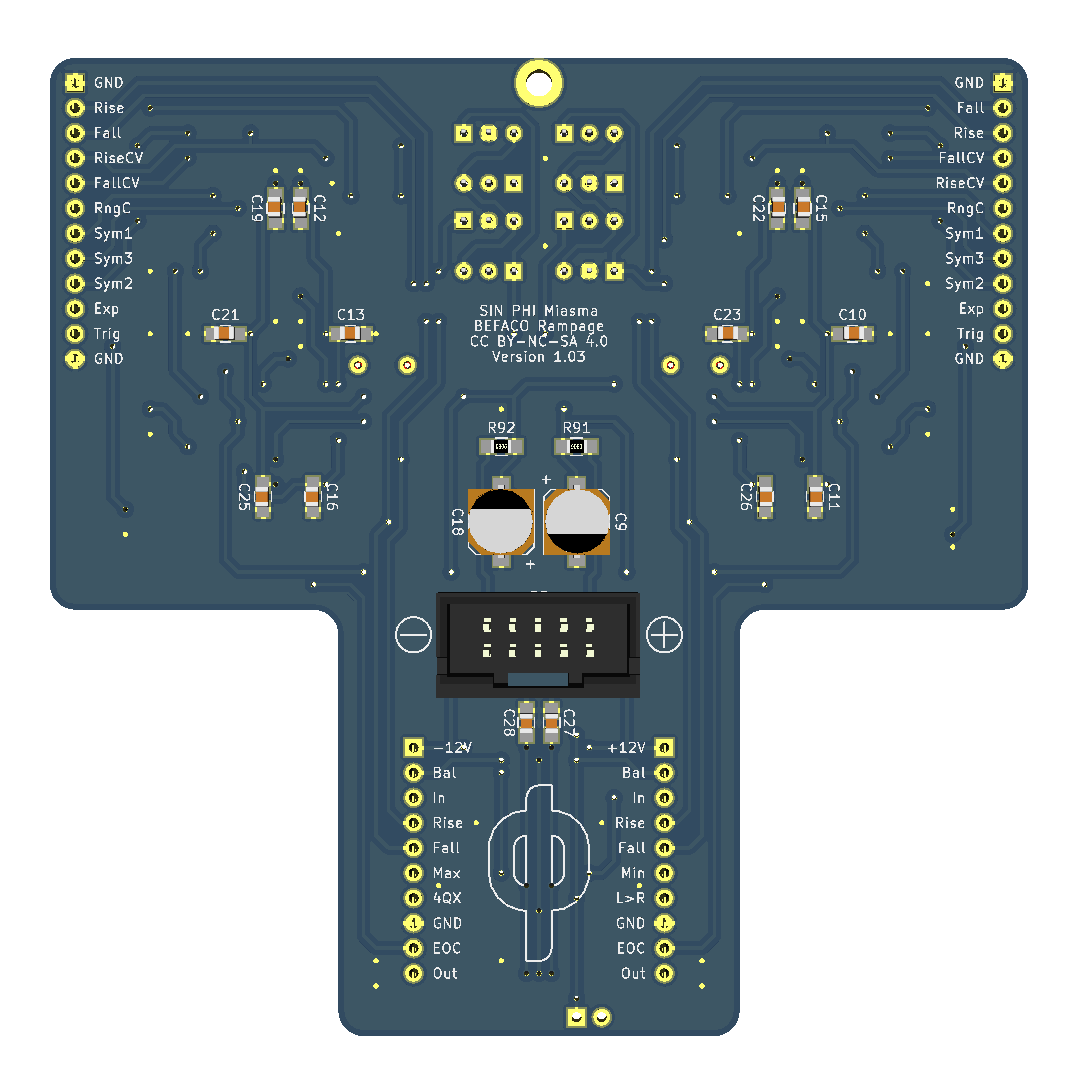Miasma: Function Generator
 Files updated 12/8/2018.
Files updated 12/8/2018.
Successful build of current files: Muffwiggler Thread
The Miasma is an extremely versatile module. This design is based on the Befaco Rampage. At its core the Miasma is a pair of bi-directional slew integrators. The Miasma has a broad range of patch programibility from oscillators and envelopes to envelope followers and low pass filters.
The Miasma features inputs for rise, fall and exponential control voltages that change the shape of the wave-forms output. The rise and fall control voltages have attenuverters and offset potentiometers. The range switch selects between fast, mid and slow rates. Shape of the waveform can be set with a potentiometer from exponential rise and logarithmic fall, linear rise and linear fall, or logarithmic rise and exponential fall. Input for the trigger starts the cycle. The cycle can be reset while falling. The trigger momentary switch can trigger either side. The cycle input inverts the cycle switch which selects between looping or singular.
The Miasma outputs for each function generator are rising and falling gates, end of cycle trigger and bipolar output. The balance potentiometer sets the level going into the analog minimum, maximum, left greater than right comparator and an AD633 four quadrant multiplier.
Enhancements on the Rampage include the CV attenuverters, the four quadrant multiplier, pull down resistor on logic outputs and SMD layout for easy DIY construction. The AD633 can be optionally left off and jumpers used so that the 4QX output becomes an inverted sum of the left and right signals through the balance potentiometer.
CC BY-NC-SA 4.0
Schematic
PCB Layout

|

|

|

|
Panel Design
Bill of Materials
PDF Bill of Materials
Cost of parts estimate of ~$100.
Tuning and Calibration
Connect the OUT output to an oscilloscope. Use the mid setting of the RANGE switch. Set to cycle on the CYCLE switch and use the manual trigger TRIG switch. Set rise and fall to minimum. Turn the SHAPE potentiometer fully clockwise. Rise and fall times should be equal. If they are not adjust the symmetry trimmer. Repeat for the other side.
Patch Programming
Envelope Generators
Attack-Release Envelope Generator: For an AR envelope patch a trigger into the TRIG input. An AR envelope is generated at the OUT with the attack and release controlled by the RISE and FALL pots respectively.
Attack-Sustain-Release Envelope Generator: An ASR envelope can be made by patching a gate into the IN input. The output will sustain as long as the gate is high. Attack and release are again controlled by RISE and FALL pots.
Complex Envelopes: Complex envelopes can be created by mixing the outputs of more than one slope generator together. As an example one half of the Miasma could handle the attack and decay while the other performs the sustain and release.
Oscillators
To make an oscillator first patch the EOC into the TRIG or set the CYCLE switch to repeat. The slope generator will start to oscillate with the frequency determined by the RISE and FALL pots.
Square Wave: To take the square wave output just patch into the RISE or FALL jack.
Triangle/Saw Wave: To take the triangle/saw wave output just patch into the OUT jack. The shape can be controlled by adjusting the RISE and FALL pots. A short rise and slow fall giave a saw waveform, a slow rise and quick fall gives a ramp and equal times a triangle. This shape can be modulated by patching a control voltage into the CV; with the modulation target controlled by the RISE:BOTH:FALL switch.
Complex Wave-forms: Composite waves from more than one slope generator can be mixed to create new wave-forms.
Soften Wave-forms: to create 'softer' triangle and square wave-forms the output can be run through a slope generator programmed as a Slew Generator.
Trigger/Gate Delay
Patch a trigger or gate signal into the TRIG jack and take the delayed signal from the GATE OUT jack. The amount of delay is set by the sum of the RISE and FALL pots. Output may need to be inverted if the falling or rising edge is desired.
Subharmonic Generator
This is set up similar to the Trigger/Gate Delay so that the Miasma can be re-triggered by an audio signal and the output will be a square wave that is a sub-harmonic of the original signal. Patch an audio signal into the TRIG jack and take the output from the GATE OUT jack. This will have to be tuned and input signal may need to be squared up.
Envelope Follower
Patch a auido signal into the IN jack and set the RISE pot to fast. Set the FALL pot to fast and turn down until the signal at the OUT jack follows the waveform of the audio input signal.
Directional CV Glide
Patch the control voltage into the IN jack and the slewed signal will be on the OUT jack. The RISE and FALL pots control the slew up or down respectively. The output signal can be used to control an oscillator's pitch creating glide or portamento. The Portamento doesn't have to be bipolar; it can be just on the up, the down or asymmetrical. To achieve an exponential response stack a patch cable from the OUT jack to the CV jack and adjust the curve with the CV LEVEL pot.
Low Pass Filter
A lo-fi low pass filter can be created with this patch by setting RISE and FALL pots relatively fast. Use the control voltage inputs for voltage control of the filter.
Lopsided Recursive Waveform Generator
Patch an oscillator on both halves of the Miasma. Patch the output of each half of the Miasma into the CV of the other half. Stack a patch cable onto one of the outputs and use a lopsided recursive waveform.
Chaotic Waveforms
Cross-connecting two Slope Generators together generates interesting 'chaotic' wave forms. Connect the output of one to the attenuated VC input of the other, then take the output of the second and patch it to the input of the first. Play with the attenuator settings.
Specifictations
| Width | Depth | +12 V | -12 V |
| 20 hp | 30 mm | 115 mA | 90 mA |